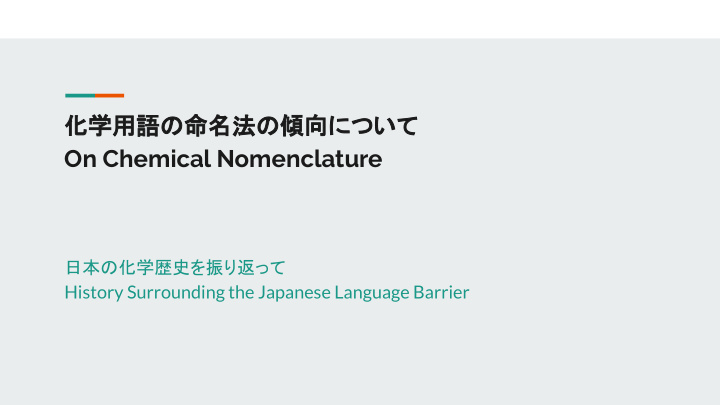



化学用語の命名法の傾向について On Chemical Nomenclature 日本の化学歴史を振り返って History Surrounding the Japanese Language Barrier
Introduction 化学は古来から何か国で勉強されたのに、よく理解されたのは過去数世紀以内です 。 Chemistry has been pondered and studied for ages, but has only been well understood within the last few centuries. Chemical terminology is very complex!
Driving question: how were chemistry’s concepts and conventions introduced to Japanese through the language barrier?
Antoine Lavoisier - the father of modern chemistry Lavoisier, born in Paris in 1743, revolutionized chemistry with his findings. Discouraged from science by his father, he initially studied for and obtained a law degree.
Lavoisier’s work Published the law of conservation of mass ● Discovered that diamond, charcoal, and carbon dioxide all were composed of the same substance; ● called it “carbon” Determined that sulfur was indivisible into smaller substances, therefore an element ● Coined names for oxygen and hydrogen ●
舎密開宗
鎖国 日本は1633年ごろから1853年まで「鎖国」をしました。 その時、他の国とあまり貿易をしませんでした。 From 1633 until 1853, Japan underwent its sakoku or closed-country period. During this time, it did not trade with other nations, and people were largely not allowed in or out.
しかし、オランダとだけ貿易をしました ! However, they did trade with the Dutch! During this time, Japanese who studied the Western technology and science brought by the Dutch were called 蘭学者 (rangakusha) , or Dutch scholars One particular rangakusha of note was Udagawa Youan
宇田川榕菴 宇田川榕菴は 1830年ごろオランダ語に翻訳された「 The Elements of Experimental Chemistry 」という本を手に入れました。 宇田川さんは読んで、自分の実験をして、自分の本を書きました。 Udagawa obtained a Dutch translation of William Henry’s book, “the Elements of Experimental Chemistry,” in about 1830. After reading it and conducting his own experiments, Udagawa wrote his own book.
舎密開宗 (せいみかいそう) - seimi kaisou
Udagawa created many terms in Japanese which are still used today; among them, 酸素 (oxygen) , 炭素 (carbon) , and 水素 (hydrogen) . In addition, he named processes like 酸化 (oxidation) , 還元 (reduction) , and 溶解 (dissolution) . This was the first introduction of the findings of Lavoisier to Japan!
化学の命名法
Japanese syllabaries ひらがな - Hiragana - purely phonetic カタカナ - Katakana - also purely phonetic, used mainly for foreign words 漢字 - Kanji - borrowed from Chinese, each character has its own meaning
周期表 The elements of the periodic table can be organized by which syllabary their names use. In this figure, red elements use katakana transliterations of their english names, blue use katakana transliterations of their latin names, yellow use kanji to denote uniquely Japanese names, and orange use a mix of both syllabaries.
Elements with unique kanji names Hydrogen H 水素 Iron Fe 鉄 Carbon C 炭素 Copper Cu 銅 Nitrogen N 窒素 Zinc Zn 亜鉛 Oxygen O 酸素 Silver Ag 銀 Phosphorus P 燐 Platinum Pt 白金 Gold Au 金 Sulfur S 硫黄 Mercury Hg 水銀 Chlorine Cl 塩素 Lead Pb Bromine Br 鉛 臭素
Elements with katakana names The majority of the metals, as well as the noble gases, use katakana transliterations of their english or latin names—for example: リチウム richiumu - lithium ● タングステン tangusuten - tungsten ● イリジウム irijiumu - iridium ● ナトリウム natoriumu - sodium (from “natrium”) ●
Elements whose names use both katakana and kanji Boron B ホウ素 Fluorine F フッ素 Silicon Si ケイ素 Arsenic As ヒ素 Iodine I ヨウ素
Naming chemical compounds in Japanese
Acids and salts - 酸や塩など “Acid” and “salt” use the same kanji as do “oxygen” and “chlorine,” respectively. This is a bit of a misnomer; Lavoisier had incorrectly postulated that oxygen was crucial to the formation of acids!
Salts 日本語で、陰イオン名は最初に来ます。 英語 - sodium chloride —> 日本語 - 塩化ナトリウム 「化」 - “change;” used in this case to link the two ions
Acids Simple acids are just denoted with 酸 ; eg, hydrochloric acid (HCl) simply becomes 塩酸 . Polyatomic ions are named with similar conventions as in english; below are some examples aligned with their english counterparts.
IUPAC - 国際純正・応用化学連合 20 世紀初頭 , 国際純正・応用化学連合は生まれました。 そして、有機化合物の 規定的な名前を作るシステムが初めて生まれました。 In the early 20th century, the International Union of Pure and Applied Chemistry was formed. The IUPAC created a standardized system for naming organic compounds. This translates directly into Japanese via katakana .
These rules would be very complicated to summarize completely; shown are some basic organic molecules and their standardized names.
Problems with katakana transliteration カタカナに翻訳するのはあいまいになる場合があります。 When converting words to katakana , English’s sounds are inherently more specific, so ambiguity may arise. PH 5 Phosphorane ホスホラン Phospholane 1 H ホスホラン
外来語 The adoption of foreign words into Japanese via katakana is referred to as 外来語 (gairaigo) . While extremely common in modern Japanese, this was not the case until well after sakoku ended. For Udagawa, it likely made more sense and was easier to devise Japanese names for chemical elements at the time. Likewise, as chemistry grew more comprehensive, the use of katakana and adherence to international nomenclature became the more convenient choice.
Conclusions The modernization of the Japanese language itself is reflected in chemical terminology!
References Johanning, J. (Nov. 2003) Problems in translating Japanese chemical texts to English . http://hugepatheticforce.org/chem-for-translators.pdf Ichige, M; Sugita, K. (31 Mar. 2014) A guidebook for etymology of chemical elements . https://opac.ll.chiba-u.jp/da/curator/100517/B9784903328164.pdf Sayle, R. (21 Jul 2008) Foreign Language Translation of Chemical Nomenclature by Computer . https://pubs.acs.org/doi/pdf/10.1021/ci800243w Helmenstine, T. (3 Dec 2017) List of Elements in Japanese . https://sciencenotes.org/list-elements-japanese/ Waseda University Library. n.d. Seimi Kaisou . ttps://www.wul.waseda.ac.jp/kosho/bunko08/b08_b0027/ https://kotobank.jp/word/%E8%88%8E%E5%AF%86%E9%96%8B%E5%AE%97-86508 https://web.lemoyne.edu/~giunta/EA/LAVPREFann.HTML https://www.famousscientists.org/antoine-lavoisier/ Irwin, M. (2011) Loanwords in Japanese . https://books.google.com/books?id=lb1xAAAAQBAJ&pg=PA25&lpg=PA25&dq=gairaigo+timeline&sou rce=bl&ots=o-qSG_kucJ&sig=ACfU3U27Tb49GMY4qy0X14N8_m69DorDxA&hl=en&sa=X&ved=2ahUKEwiP 5pq6ro7pAhXolXIEHeyeCXkQ6AEwAXoECAkQAQ#v=onepage&q=gairaigo%20timeline&f=false
Recommend
More recommend